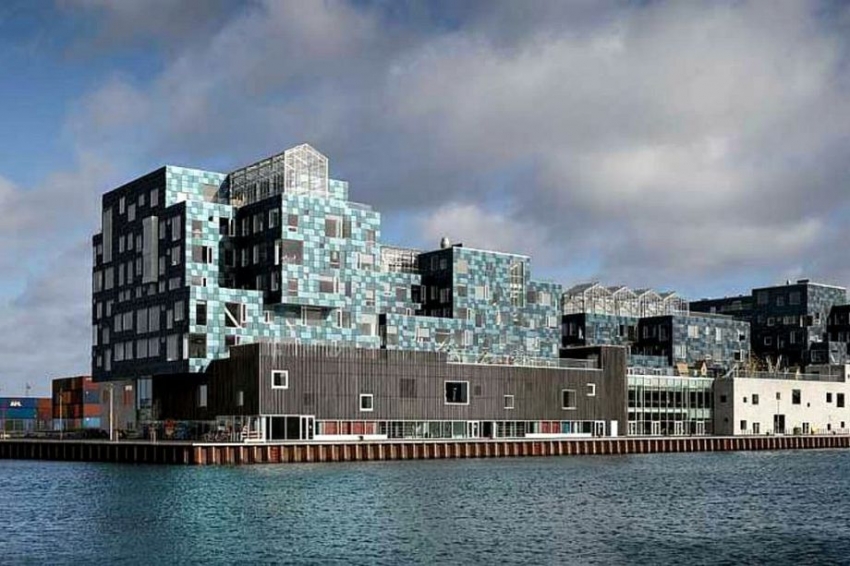The façade of this school in Copenhagen is covered with 12,000 panels adding unique architectural details

The panels, spanning over an area of 65,000ft2, cover roughly half of the building’s power consumption
The Copenhagen International School (CIS)- Nordhavn is one of Denmark’s biggest building-integrated solar power plants in the country, as it is designed with 12,000 blue-green photovoltaics on its façade. Actually, the custom-build panels span almost over the entire building’s exterior and are part of its architectural design, while providing enough energy to cover at least half of its power consumption.
The panels, which cover a total area of approximately 6,000 m2 (65,000 ft2), were created by the Swiss research institute École Polytechnique fédérale de Lausanne (EPFL), where engineers had to incorporate extremely fine particles of colored glass in the surface of the panel to allow letting through the same amount of light as an entirely clear pane of glass. The panels are also “individually angled to create a sequin-like effect.â€
The building’s design was undertaken by the Scandinavian architecture firm C.F. Møller , while the project’s funding was secured through private donations, financial reserves within the school, and bank loans.
Other innovative and ‘green’ characteristics
Multiple towers consist the school’s main building, hosting the students depending on their age: Early Years, Primary School, Middle School and High School. All the towers sit atop a common ground floor with a cafeteria, library, sports facilities and performance spaces, while a large promenade outside of the building offers space for stretching out or recreation. Classrooms for young children are designed extra-large to account for all the various activities taking place therein and include green spaces and physical education areas. “We are proud that through the construction of the school, we will be able to take the lead and set a good example by showing how you can integrate innovative architecture into the curriculum,†Brit van Ooijen, Chair of the Board for Copenhagen International School said, adding that "Our aim is to strengthen the student’s competencies in an international environment so they will become competent world citizens with a focus on sustainability.â€
Apart from the solar panels, the school is also equipped with many more ‘green’ characteristics according to the 2020 environmental building guidelines: LED lights, natural ventilation, rainwater harvesting and use of secondary water for toilet flushing. There are sensors controlling all water faucets and lights, while CO2 and temperature levels are constantly monitored and adjusted to save energy and optimize comfort. There are greenhouses on top of each tower from which students can use vegetables for their cooking classes, and as far as biological waste from the kitchen is concerned, it is fed to a bio tank and reused to feed animals.


Source: Green Matters
Want to read more like this story?

Saudi Arabia’s ‘smartest’ building, designed by Zaha Hadid Architects, recently opened to the public
Dec, 08, 2017 | NewsThe King Abdullah Petroleum Studies and Research Centre (KAPSARC), rising out of the desert landscap...

Syria: 316 schools were restored and fully equipped after last year’s catastrophic earthquake
Jul, 22, 2024 | NewsAfter the catastrophic earthquake in February 2023 in Aleppo province, Syria, 1019 schools were dam...

Video with the most captivating 2017 Structural Engineering News
Jan, 15, 2018 | NewsThestructuralengineer.info is pleased to launch a video with a selection of the most captivating new...

School building collapse in Nigeria: At least 9 people dead
Mar, 18, 2019 | NewsOn Wednesday, March 13, 2019, a 3-story building collapsed in Lagos, the largest city of Nigeria, ca...

Design Challenges and Structural Analysis Optimization of Solar Panels
Jul, 18, 2022 | NewsThe use of non-renewable source of energy in generation of electricity has led to emission of pollu...

Power in partnership: Free US sustainability training platform launches with industry leaders to transform supply chains
Jan, 28, 2025 | NewsKeller, CRH, Fluor, National Grid, and Burns & McDonnell join forces with the Supply Chain Sust...

Altair will be the tallest residential towers in Sri Lanka
Feb, 22, 2018 | NewsThe iconic towers, one vertical and the other one tilted, will consist of 68 and 64 floors respectiv...

Thousands of Los Angeles buildings may need to be seismically retrofitted after PEER report
Jun, 02, 2014 | NewsA decade after the identification of potentially vulnerable concrete school buildings across th...

Florida pedestrian bridge collapses 5 days after its installation
Mar, 21, 2018 | NewsThe bridge, which was expected to open in January 2019, was being built using a method called a...
Trending

New Release - STAAD.Pro 2025

Spectacular interchanges around the world

Melbourne Approves Skinny Skyscraper

STAAD.Pro 2024 New Release

China: Bridge collapse due to heavy rainfall







